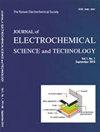Detection of Unbalanced Voltage Cells in Series-connected Lithium-ion Batteries Using Single-frequency Electrochemical Impedance Spectroscopy
IF 3
4区 工程技术
Q3 ELECTROCHEMISTRY
Journal of electrochemical science and technology
Pub Date : 2021-06-18
DOI:10.33961/jecst.2021.00115
引用次数: 2
Abstract
For a battery module where single cells are connected in series, the single cells should each have a similar state of charge (SOC) to prevent them from being exposed to an overcharge or over-discharge during charge–discharge cycling. To detect the existence of unbalanced SOC cells in a battery module, we propose a simple measurement method using a single-frequency response of electrochemical impedance spectroscopy (EIS). For a commercially available graphite/nickel-cobaltaluminum-oxide lithium-ion cell, the cell impedance increases significantly below SOC20%, while the impedance in the medium SOC region (SOC20%–SOC80%) remains low with only minor changes. This impedance behavior is mostly due to the elementary processes of cathode reactions in the cell. Among the impedance values (Z, Z , Z ), the imaginary component of Z regarding cathode reactions changes heavily as a function of SOC, in particular, when the EIS measurement is performed around 0.1 Hz. Thanks to the significant difference in the time constant of cathode reactions between ≤SOC10% and ≥SOC20%, a single-frequency EIS measurement enlarges the difference in impedance between balanced and unbalanced cells in the module and facilitates an ~80% improvement in the detection signal compared to results with conventional EIS measurements.单频电化学阻抗谱法检测串联锂离子电池中的不平衡电压单元
对于单个电池串联的电池模块,单个电池应该具有相似的充电状态(SOC),以防止它们在充放电循环过程中暴露于过充或过放电。为了检测电池模块中是否存在不平衡的SOC电池,我们提出了一种使用电化学阻抗谱(EIS)单频响应的简单测量方法。对于市售的石墨/镍钴铝氧化物锂离子电池,电池阻抗在SOC20%以下显著增加,而在中等SOC区域(SOC20% - soc80%)的阻抗仍然很低,只有很小的变化。这种阻抗行为主要是由电池中阴极反应的基本过程引起的。在阻抗值(Z, Z, Z)中,关于阴极反应的Z的虚分量作为SOC的函数变化很大,特别是当EIS测量在0.1 Hz左右进行时。由于阴极反应的时间常数在≤SOC10%和≥SOC20%之间存在显著差异,单频EIS测量扩大了模块中平衡和不平衡电池之间的阻抗差异,与常规EIS测量结果相比,检测信号改善了80%左右。
本文章由计算机程序翻译,如有差异,请以英文原文为准。
求助全文
约1分钟内获得全文
求助全文
来源期刊

Journal of electrochemical science and technology
ELECTROCHEMISTRY-
CiteScore
6.30
自引率
8.10%
发文量
44
期刊介绍:
Covering fields:
- Batteries and Energy Storage
- Biological Electrochemistry
- Corrosion Science and Technology
- Electroanalytical Chemistry and Sensor Technology
- Electrocatalysis
- Electrochemical Capacitors & Supercapcitors
- Electrochemical Engineering
- Electrodeposition and Surface Treatment
- Environmental Science and Technology
- Fuel Cells
- Material Electrochemistry
- Molecular Electrochemistry and Organic Electrochemistry
- Physical Electrochemistry
- Solar Energy Conversion and Photoelectrochemistry
 求助内容:
求助内容: 应助结果提醒方式:
应助结果提醒方式:


